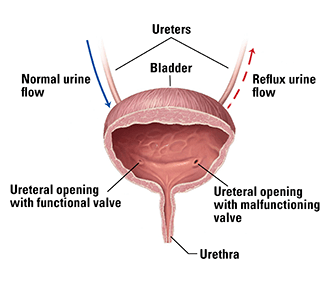Fanconi syndrome: It is an acquired or congenital cause of decreased absorption at the proximal convoluted tubule. As a result amino acids, glucose, bicarbonate, phosphate and uric acid are lost in urine. Loss of bicarbonate may cause type II renal tubular acidosis. It is seen in cystinosis, tyrosinemia, Wilson disease, galactosemia, fructose intolerance, lead poisoning, Legionella pneumonia, multiple myeloma, ALL, use of antivirals like NRTIs, ranitidine, cisplatin, azathioprine, gentamicin etc. It presents with symptoms of the underlying disorder and osteomalacia, rickets, dehydration, electrolyte imbalances, metabolic acidosis, failure to thrive, paresthesias, muscle weakness, CCF etc. Management is by treating the underlying disorder, replacing fluid and electrolytes, Vit D and phosphate replacement, and managing acid-base balance.
Vesicoureteral reflux or VUR: It is the retrograde flow of urine from the bladder back into the ureters due to an improper functioning vesicoureteric junction. As a result, urine backflows into the ureter and kidneys (sometimes) during micturition. It commonly presents in childhood. It may be asymptomatic or present with recurrent UTIs, urinary incontinence, bedwetting, constipation and urinary retention. Recurrent UTIs may cause renal scarring leading to ESRD. It may predispose to HT in later life. This is seen when UTIs are not diagnosed and treated promptly. VUR can be primary (more common) or secondary. Primary VUR results from incompetence of the vesicoureteric junction. It may be unilateral or bilateral. Most children with primary VUR get better as they grow as the valve matures. Secondary VUR results from valve incompetence as a result of secondary factors such as posterior urethral valves, ureterocele, urethral or meatal stenosis and neurogenic bladder. Secondary VUR is often bilateral.

It is diagnosed by a voiding cystourethrogram which demonstrates the reflux. Abdominal ultrasound will show dilated ureters and kidneys. Some cases can be diagnosed by prenatal ultrasound. Management is with treating UTIs, low-dose prophylactic antibiotics to prevent UTIs, treatment of underlying disorder in secondary VUR, intermittent bladder catheterization and surgery to remove any stenosis.
Posterior urethral valves: It is a common cause of obstructive uropathy especially common in male infants. Posterior urethral valves cause congenital obstruction of the posterior urethra. The valves result from incomplete dissolution of the urogenital membrane, hypertrophied urethral folds or folds of verumontanum. It may be associated with hypospadias, prune belly syndrome, PUJ obstruction and renal ectopia. It presents antenatally with hydronephrosis detected on routine antenatal ultrasound. Other symptoms are poor urinary stream, UTIs, VUR, bed-wetting, hematuria, urinary retention and failure to thrive. ESRD may occur. Ultrasound shows hydronephrosis, thickened bladder wall, renal cysts and keyhole sign in the bladder neck. Investigation of choice is VCUG (voiding cystourethrogram) that shows a dilated posterior urethra, trabeculated bladder, VUR and abnormal valves. Management is with relieving hydronephrosis and urinary retention by catheter drainage, antibiotics as needed, monitoring renal function, endoscopic ablation of the abnormal valves, vesicostomy and upper urinary tract diversion surgery in resistant cases. Some centers consider antenatal interventions to preserve long term renal function, if expertise is available, as the disorder starts in early fetal life.
Urethral stricture: It is the narrowing of the urethra from scarring and fibrosis. It is much more common in men than women. Causes include gonorrhea, balanitis xerotica obliterans, traumatic rupture of urethra in pelvic fractures, invasive procedures in the urethra like transurethral resection of the prostate, indwelling catheters, brachytherapy etc. Strictures are most common in the bulbar urethra while prostatic and membranous urethra are more commonly involved following pelvic fractures. Symptoms include straining during urination, incomplete emptying of the bladder, increased frequency and urgency. Some patients may present with acute retention of urine. Diagnosis can be confirmed by uroflowmetry, retrograde cystourethrography and VCUG. Suprapubic rather than transurethral catheterization should be done in patients presenting with urinary retention from urethral stricture. Surgical management is with internal urethrotomy, resection of stricture with end-to-end anastomosis, urethroplasty and urethrostomy.

Cystourethrogram of a bulbar urethral stricture about 3 cm in length
Traumatic injuries of the urethra: Injuries of the anterior urethra are mostly caused by blunt or penetrating trauma, straddling injuries and iatrogenic injuries from instrumentation. Injuries to the posterior urethra occur with pelvic fractures as seen in traffic accidents. Indications of urethral injury are blood at the urethral meatus, penile hematoma and high-riding prostate. Urethral instrumentation and catheterization should be avoided in the presence of blood at the urethral meatus to avoid further damage to the urethra. Suprapubic catheterization should be done instead. Gold standard for diagnosis is retrograde urethrography. Extravasation of contrast agent is seen into the pelvis in the presence of urethral disruption. Conservative management is preferred in stretch injuries or partial disruptions while urethroplasty is done for complete disruptions.

Cystourethrogram of a normal urethra, showing the anatomical segments
Sign up for free to take 2 quiz questions on this topic